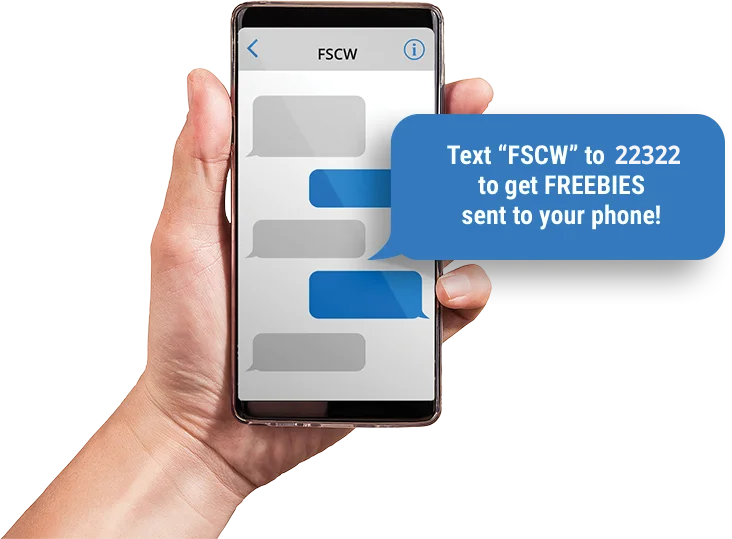For freebies, deals, discounts, and flash sales sign up for the Full Service Car Wash Text program. You can stop at any time by simply sending “STOP” to the service—but the deals are so good you won’t want to.
Is it better to hand wash your vehicle?
Everyone has seen the cliché car commercial: father and son, standing in the driveway, handwashing Dad’s new car; but is that really the safest and most effective way to keep your car clean? Most people you ask will say hand washing your vehicle is the safest way to protect its delicate finish, especially compared to a soft touch, automatic car wash. They make these assumptions without considering the science behind the different ways to fulfill our vehicle cleaning needs. Keep reading to learn why FSCW is proud to be a soft touch car wash.
How Hand Washing Works
Most people are aware of how hand washing a vehicle is accomplished: add a glug of hand car wash soap from the local auto parts store in a bucket filled with garden hose water, apply the soap mixture to the car with a sponge, rinse with the garden hose, and wipe afterward with a dry towel. We’ve all probably done this. In order to better understand the original question, however, let’s break down how a professional soft touch car wash works.
How a Soft Touch Car Wash Works
First, in soft touch car washing, closed cell foam is flooded with water and a mild soap that has lubrication properties. This combination of spinning foam material flooded with the soap/water solution makes contact with the surface of a vehicle using the help of computer-controlled pressure and RPM settings. This “soft touch” contact breaks the bond that the dirt particles have made with the surface of the vehicle. Centrifugal forces combined with the constant flooding of soap and water on the closed cell foam make sure dirt and debris is removed from the car surface, and not transferred between vehicles or back to the same vehicle. Following this process, low pressure softened water is used to rinse the remaining soap/water solution off of the vehicle. The vehicle then has a hydrophobic “cold wax” solution applied to it and is sent through a forced air dryer. In full service washing, an extra step is added to the beginning and end of the process. Before the car is sent through the mechanical wash, it is hand prepped with a pressure washer which removes large debris from the vehicle. Finally, after the mechanical wash process, the vehicle is hand towel dried, removing the rest of the water that the forced air dryers could not.
How and Why Are They Different
Comparing the two methods, both processes seem very similar, however, there are some very distinct differences between the two. The first major difference is with the pre-wash process. A reputable car wash that hand preps your vehicle with a special prep gun, removes large debris from the vehicle safely before it enters the mechanical car washing process. This ensures the soft touch material will safely remove the finer surface contaminates more effectively. While some people do use a pressure washer on their vehicle before they hand wash it with a mitt or sponge, this method is not always followed. While a nozzle attachment on a garden hose can increase water pressure, it is not enough to remove the larger debris. On the other side of the spectrum, the utility pressure washers people use to prewash their vehicles have far too high PSI of water pressure. These washer units are meant for cleaning sidewalks and removing paint from decking, which is something that is not safe for the surface finish of a vehicle.
The biggest difference lies between the two car washing methods. In a soft touch wash, the combination of flooding the closed cell foam wash material with soap and water, combined with the centrifugal forces of the spinning equipment, means that all contaminates that get removed from the vehicle immediately after making contact with the soft touch material. When hand washing takes place, there is no constant rinsing of the wash material or centrifugal force. While the bond is broken between the contaminants and the surface of the vehicle, the grit and dirt is not washed away and ends up trapped under the cleaning surface, scratching the vehicles finish, like a fine sandpaper.
What The University of Texas and The University of Munich Found
These articles from Google News as well as Quora.com discuss this process in relation to a study conducted by the Technical University of Munich, funded by Mercedes-Benz as well as a duplicated study by the University of Texas.
- Quora Article - Pros and Cons of Handwashing Your Car
- Google News Article - Handwashing Car is Harfmul
Both studies confirmed, under real world conditions, that using a soft touch car wash was the safest and most effective way to keep your car clean. Compared to hand washing, which noticeably scratched and dulled the vehicle’s painted surface (penetrating up to 10% of the finish), soft touch washing left no visible markings. Under a microscope, it was determined by scientists in both studies that using a soft touch wash left your vehicle’s paint luster 300%-700% more reflective in comparison to hand washing.
Why Full Service Car Wash is Soft Touch
At Full Service Car Wash, we have been using soft touch washing to build our business over the last 30 years by safely cleaning many millions of cars in the greater Milwaukee area. Because our company is completely committed to providing the best car wash we can offer, we prefer a method that is safer and more effective for our customers. While we do get requests to hand wash vehicles, a service that we still will provide, we always refer and try to convince these requests to our normal soft touch car wash process- the safest and most effective way to keep your car clean.

